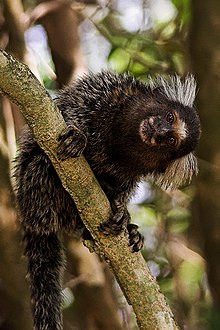Marmoset
.mw-parser-output table.biota-infoboxtext-align:center;width:200px;font-size:100%.mw-parser-output table.biota-infobox th.section-headertext-align:center.mw-parser-output table.biota-infobox td.section-contenttext-align:left;padding:0 0.25em.mw-parser-output table.biota-infobox td.list-sectiontext-align:left;padding:0 0.25em.mw-parser-output table.biota-infobox td.taxon-sectiontext-align:center;padding:0 0.25em.mw-parser-output table.biota-infobox td.image-sectiontext-align:center;font-size:88%.mw-parser-output table.biota-infobox table.taxonomymargin:0 auto;text-align:left;background:transparent;padding:2px.mw-parser-output table.biota-infobox table.taxonomy trvertical-align:top.mw-parser-output table.biota-infobox table.taxonomy tdpadding:1px
| Marmosets[1][2] | |
|---|---|
 | |
Common marmoset (Callithrix jacchus) at Tibau do Sul, Rio Grande do Norte | |
Scientific classification | |
| Kingdom: | Animalia |
| Phylum: | Chordata |
| Class: | Mammalia |
| Order: | Primates |
| Suborder: | Haplorhini |
| Infraorder: | Simiiformes |
| Parvorder: | Platyrrhini |
| Family: | Callitrichidae |
| Groups included | |
| |
Cladistically included but traditionally excluded taxa | |
| |
The marmosets, (/ˈmɑːrməˌzɛts, -ˌsɛts/[3][4]), also known as zaris, are twenty-two New World monkey species of the genera Callithrix, Cebuella, Callibella and Mico. All four genera are part of the biological family Callitrichidae. The term marmoset is also used in reference to the Goeldi's marmoset, Callimico goeldii, which is closely related.
Most marmosets are about 20 centimetres (8 in) long. Relative to other monkeys, they show some apparently primitive features: they have claws rather than nails, and tactile hairs on their wrists. They lack wisdom teeth, and their brain layout seems to be relatively primitive. Their body temperature is unusually variable, changing by up to 4 °C (7 °F) in a day.[5] Marmosets are native to South America and have been found in Bolivia, Brazil, Colombia, Ecuador, Paraguay and Peru.[6] They have also been spotted in Central America and Mexico.[7] They are also raised in captivity as pets.
According to recent research, marmosets exhibit germline chimerism, which is not known to occur in nature in any primates other than callitrichids.[8] 95% of marmoset fraternal twins trade blood through chorionic fusions, making them hematopoietic chimeras.[9][10]
Contents
1 Etymology
2 Species list
3 Behavior
4 References
5 External links
Etymology
Callithrix comes from Ancient Greek and means "beautiful fur". Marmoset, from the French marmouset, is of uncertain etymology, although these monkeys are currently called ouistiti in French.
Species list
- Genus Callithrix—Atlantic marmosets
Common marmoset, Callithrix jacchus
Black-tufted marmoset, Callithrix penicillata
Wied's marmoset, Callithrix kuhlii
White-headed marmoset, Callithrix geoffroyi
Buffy-headed marmoset, Callithrix flaviceps
Buffy-tufted marmoset, Callithrix aurita
- Genus Mico—Amazonian marmosets
Rio Acari marmoset, Mico acariensis
Silvery marmoset, Mico argentatus
White marmoset, Mico leucippe
Emilia's marmoset, Mico emiliae
Black-headed marmoset, Mico nigriceps
Marca's marmoset, Mico marcai
Black-tailed marmoset, Mico melanura
Santarem marmoset, Mico humeralifer
Maués marmoset, Mico mauesi
Gold-and-white marmoset, Mico chrysoleucos
Hershkovitz's marmoset, Mico intermedius
Satéré marmoset, Mico saterei
Rondon's marmoset, Mico rondoni
- Genus Callibella—Roosmalens' dwarf marmoset
Roosmalens' dwarf marmoset, Callibella humilis
- Genus Cebuella—Pygmy Marmoset
Pygmy marmoset, Cebuella pygmaea
Behavior
Marmosets are highly active, living in the upper canopy of forest trees, and feeding on insects, fruit, and leaves. They have long lower incisors, which allow them to chew holes in tree trunks and branches to harvest the gum inside; some species are specialised feeders on gum.[citation needed]
Marmosets live in family groups of three to 15, consisting of one to two breeding females, an unrelated male, their offspring, and occasionally extended family members and unrelated individuals. Their mating systems are highly variable and can include monogamy, polygyny, and polyandry. In most species, fraternal twins are usually born, but triplets are not unknown. Like other callitrichines, marmosets are characterized by a high degree of cooperative care of the young and some food sharing and tolerated theft. Adult males, females other than the mother, and older offspring, participate in carrying infants. Father marmosets are an exceptionally attentive example of fathers within the animal kingdom, going as far as assisting their mates in giving birth, cleaning up afterbirth and even biting the umbilical cords attaching their newborn offspring to their mothers. Most groups scent mark and defend the edges of their ranges, but it is unclear if they are truly territorial, as group home ranges greatly overlap.
The favorite food of marmosets is carbohydrate-rich tree sap, which they reach by gnawing holes in trunks. Their territories are centered on the trees that they regularly exploit in this way. The smaller marmosets venture into the very top of forest canopies to hunt insects that are abundant there.[7]
References
^ Groves, C.P. (2005). Wilson, D.E.; Reeder, D.M., eds. Mammal Species of the World: A Taxonomic and Geographic Reference (3rd ed.). Baltimore: Johns Hopkins University Press. pp. 129–133. ISBN 0-801-88221-4. OCLC 62265494..mw-parser-output cite.citationfont-style:inherit.mw-parser-output .citation qquotes:"""""""'""'".mw-parser-output .citation .cs1-lock-free abackground:url("//upload.wikimedia.org/wikipedia/commons/thumb/6/65/Lock-green.svg/9px-Lock-green.svg.png")no-repeat;background-position:right .1em center.mw-parser-output .citation .cs1-lock-limited a,.mw-parser-output .citation .cs1-lock-registration abackground:url("//upload.wikimedia.org/wikipedia/commons/thumb/d/d6/Lock-gray-alt-2.svg/9px-Lock-gray-alt-2.svg.png")no-repeat;background-position:right .1em center.mw-parser-output .citation .cs1-lock-subscription abackground:url("//upload.wikimedia.org/wikipedia/commons/thumb/a/aa/Lock-red-alt-2.svg/9px-Lock-red-alt-2.svg.png")no-repeat;background-position:right .1em center.mw-parser-output .cs1-subscription,.mw-parser-output .cs1-registrationcolor:#555.mw-parser-output .cs1-subscription span,.mw-parser-output .cs1-registration spanborder-bottom:1px dotted;cursor:help.mw-parser-output .cs1-ws-icon abackground:url("//upload.wikimedia.org/wikipedia/commons/thumb/4/4c/Wikisource-logo.svg/12px-Wikisource-logo.svg.png")no-repeat;background-position:right .1em center.mw-parser-output code.cs1-codecolor:inherit;background:inherit;border:inherit;padding:inherit.mw-parser-output .cs1-hidden-errordisplay:none;font-size:100%.mw-parser-output .cs1-visible-errorfont-size:100%.mw-parser-output .cs1-maintdisplay:none;color:#33aa33;margin-left:0.3em.mw-parser-output .cs1-subscription,.mw-parser-output .cs1-registration,.mw-parser-output .cs1-formatfont-size:95%.mw-parser-output .cs1-kern-left,.mw-parser-output .cs1-kern-wl-leftpadding-left:0.2em.mw-parser-output .cs1-kern-right,.mw-parser-output .cs1-kern-wl-rightpadding-right:0.2em
^ Garber, Paul A.; Estrada, Alejandro; Bicca-Marques, Júlio César; Heymann, Eckhard W.; Strier, Karen B., eds. (2008). "The Diversity of the New World Primates (Platyrrhini): An Annotated Taxonomy". South American Primates: Comparative Perspectives in the Study of Behavior, Ecology, and Conservation: Developments in Primatology: Progress and Prospects. Springer. pp. 23–54. ISBN 978-0-387-78704-6.
^ "Marmoset". Merriam-Webster Dictionary. Retrieved 2016-01-21.
^ "Marmoset". Oxford Dictionaries. Oxford University Press. Retrieved 2016-01-21.
^ Stafford, S.G. (1999). "Thermoregulatory and Endocrine Adaptations of Small Body Size in Primates". Kent State University Dissertation, QP 135.S73, 1999.
^ Primate Info Net, Callithrix Factsheet, University of Wisconsin, Madison.
^ ab "Archived copy". Archived from the original on 2005-12-11. Retrieved 2005-12-06.CS1 maint: Archived copy as title (link)
^ Ross, C.N., French, J.A., and Ortí, G. (2007). "Germ-line chimerism and paternal care in marmosets (Callithrix kuhlii)". Proc. Natl. Acad. Sci. USA. 104 (15): 6278–82. doi:10.1073/pnas.0607426104. PMC 1851065. PMID 17389380.CS1 maint: Multiple names: authors list (link)
^ Masahito Tachibana, Michelle Sparman and Shoukhrat Mitalipov (January 2012). "Generation of Chimeric Rhesus Monkeys". Cell. 148 (1–2): 285–95. doi:10.1016/j.cell.2011.12.007. PMC 3264685. PMID 22225614.
^ Gengozian, N.; Batson, JS; Eide, P. (1964). "Hematologic and Cytogenetic Evidence for Hematopoietic Chimerism in the Marmoset, Tamarinus Nigricollis". Cytogenetics. 10 (6): 384–393. doi:10.1159/000129828.
External links
- Primate Info Net Callithrix Factsheets
- Common Marmoset Care
